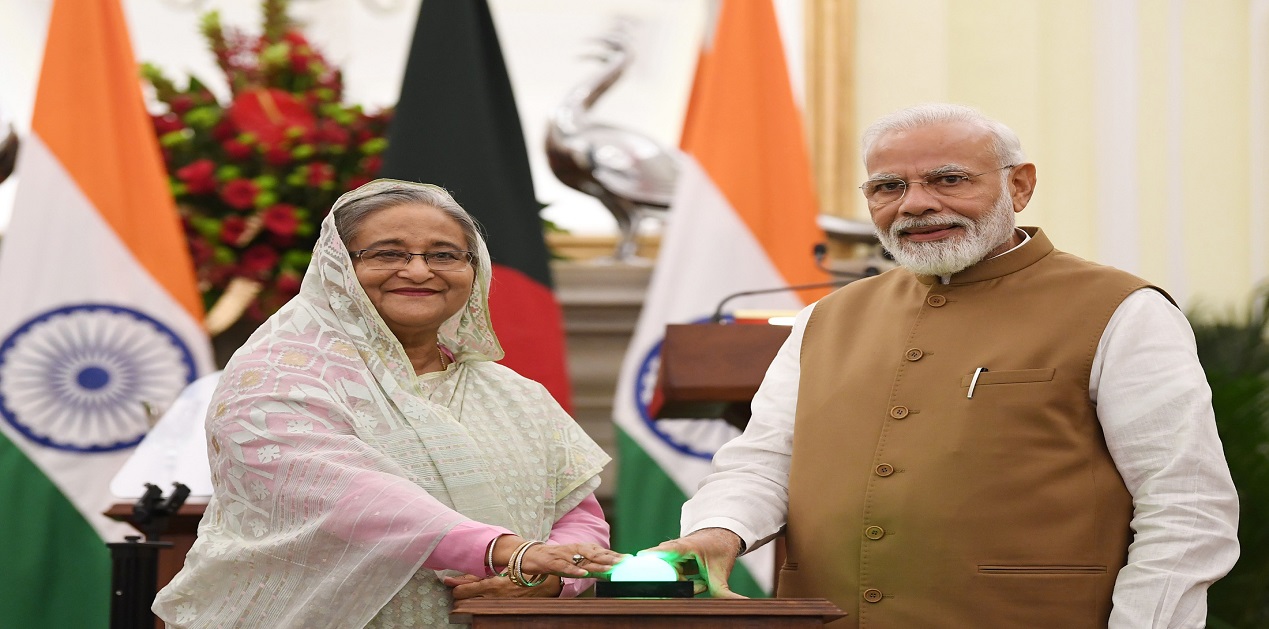India and Bangladesh are emerging economies with a combined GDP of 3000 US billion dollars (2018).1 These two big economies have forged a very strong relationship in recent years and the ties between both the countries have been on an upswing in the last decade. India and Bangladesh are one of the closest neighbours in the South Asia region and there has been regular high-level visit between both the countries. Prime Ministers of both the countries met each other on the sidelines of 74th United Nation General Assembly (UNGA) in September. Continuing with the tradition, Bangladesh’s Prime Minister Sheikh Hasina was on a four-day visit to India last week.
Prime Minister Sheikh Hasina visit began with an address at the World Economic Forum’s India Economic Summit on October 3. In her speech, she highlighted the transformation of Bangladesh economy’s growth of 188 percent since 2009.2 She also emphasized that Bangladesh’s economy was now growing at a rate of 8.1 percent and is quickly moving towards a high-value and knowledge intensive society. She urged the foreign investors and especially the Indian entrepreneurs to invest in Bangladesh in new areas such as education, artificial intelligence, light engineering and automotive industry.
During her meeting with Prime Minister Narendra Modi, the two countries signed seven Memorandum of Understanding (MoUs) on coastal surveillance system, and implementation of defense Lines of Credit (LoC). Maritime security and Indian Ocean Region have recently gained prominence in India’s foreign policy. As per the MoU signed on coastal surveillance system, India will install 24 radar systems along the coastlines of Bangladesh. India is building the coastal surveillance network with other neighbouring countries such as Sri Lanka, Maldives, Mauritius and Seychelles. This surveillance system will serve a dual purpose for India as it will help India avert any attack from the sea and also help in checking Chinese presence in the Indian Ocean region.
Other MoUs were signed on culture, youth affairs, education, usage of Chattogram and Mongla ports for movement of Indian goods, and water supply of 1.82 cusec from Feni River to Sabroom town in Tripura as a part of drinking water scheme. The diversity in terms of areas covered under MoUs shows the wide areas of cooperation between India and Bangladesh.
India and Bangladesh also jointly inaugurated Vivekananda Bhaban (students’ hostel) at Ramakrishna Mission in Dhaka, Bangladesh-India Professional Skill Development Institute (BIPSDI) at the Institution of Diploma Engineers Bangladesh (IDEB) in Khulna and bulk import of LPG from Bangladesh to northeast India.3 This year the two countries in total have jointly inaugurated 12 projects via video link. 4 The inauguration of BIPSDI will help Bangladesh produce more skilled labour force for its growing economy. In the present time when Bangladesh is moving towards becoming knowledge-intensive society, centres like these will aid in the development of the country. The export of LPG cylinder from Bangladesh to northeast India will be a win-win situation for both the countries as it will help Bangladesh reduce the trade deficit with India and it will lead to cheaper LPG cylinder for the people of northeast India.
In the joint statement issued after the meeting, PM Modi extended his government’s support towards Sheikh Hasina’s vision of a prosperous, peaceful and developed Bangladesh. He also appreciated her government’s zero-tolerance policy against terrorism. The joint statement also mentioned the need to ease the people-people movement, the positive impacts of border haats in the lives of people, measures to increase bilateral trade and boosting connectivity.
Water sharing has been a major issue between India and Bangladesh. India and Bangladesh share 54 common rivers and other than Ganga there is no agreement on any other river. In the joint statement issued during the visit, the two leaders have asked the officials to prepare the draft framework agreements for the six rivers (Manu, Muhuri, Khowai, Gumti, Dharla and Dudhkumar). Although the issue of sharing Teesta river water remained unsolved. In the joint statement, “Prime Minister Modi informed that his government is working with all stakeholders in India to conclude the agreement at the earliest.” The biggest roadblock to Teesta is the opposition by West Bengal Chief Minister Mamata Banerjee.
The other major issue which was discussed during the visit was Rohingyas. The Indian side appreciated Bangladesh for its humanitarian efforts in sheltering Rohingya refugees and in the joint statement both the Prime Ministers agreed that the Rohingyas should be safely expedited to their homes in the Rakhine state in Myanmar. India is in the favour of reparation of Rohingya and this was also reflected during the recent visit (August 19-21), of India’s External Affairs Minister, S. Jaishankar to Bangladesh where he said, “India wants a safe, speedy and sustainable return of displaced persons which is in the interest of all the three countries.”5 Bangladesh is getting tired of providing shelter to Rohingya refugees and some groups in Bangladesh sees them as a national security threat. It wants this crisis to be solved at the earliest and expects India to use its good relations with Myanmar’s government to facilitate the return of refugees.
PM Modi had assured PM Sheikh Hasina on the National Register of Citizens (NRC) issue that it will not affect their bilateral relationship during their meeting on the sidelines of the 74th UNGA. The issue of NRC was absent in the joint statement although Prime Minister Sheikh Hasina said that she was satisfied with Prime Minister assurance over the issue. India has always maintained the position that NRC in Assam is an internal matter process.
India and Bangladesh share very warm relations between each other. The relationship between both the countries at present has come a long way since the inception of Bangladesh in 1971. The major upswing in the relationship started with the coming back of Awami League in power in 2009. The signing of the Land Boundary Agreement was a major milestone in the bilateral relation as it was a long-outstanding issue. In the last ten years, the bilateral relationship has grown in every sphere such as trade, connectivity, people-people movement, security cooperation, aid, education and energy security.
PM Modi in his first tenure showed the importance of neighbourhood countries by calling the leaders of SAARC nations and the introduction of ‘Neighbourhood First’ policy. Although much progress was not possible in SAARC. In its second tenure as PM, Narendra Modi has turned his focus area from SAARC to BIMSTEC. A lot of push has been given to BIMSTEC as it is considered to be a bridge between South Asia and South-East Asia and gives more opportunities to India to foster a relationship in the region.
Bangladesh is part of both SAARC and BIMSTEC and is an important country for the success of both ‘Neighbourhood First’ and ‘Act East’ policy. Bangladesh is also needed for the growth of northeast as it shares its borders with a large part of northeast India. For the achievement of sustainable development both India and Bangladesh need a strong partnership between them. Also, the outcomes of the current visit have the potential to foster our relations with Bangladesh further.
Endnotes
- Data.worldbank.org
- https://www.weforum.org/agenda/2019/10/bangladesh-is-booming/
- https://www.mea.gov.in/bilateral-documents.htm?dtl/31911/indiabangladesh+joint+statement+during+official+visit+of+prime+minister+of+bangladesh+to+india
- https://www.mea.gov.in/Speeches-Statements.htm?
- http://www.newsonair.com/News?title=EAM-S-Jaishankar-to-hold-talks-with-Bangladeshi-counterpart-Dr.-A-K-Abdul-Menon-today&id=370367
(The paper is the author’s individual scholastic articulation. The author certifies that the article/paper is original in content, unpublished and it has not been submitted for publication/web upload elsewhere, and that the facts and figures quoted are duly referenced, as needed, and are believed to be correct). (The paper does not necessarily represent the organisational stance... More >>
Image Source: https://www.pmindia.gov.in/wp-content/uploads/2019/10/H2019100577759.jpg










Post new comment